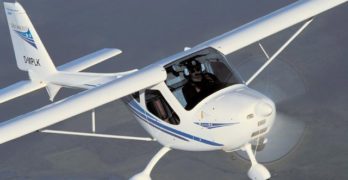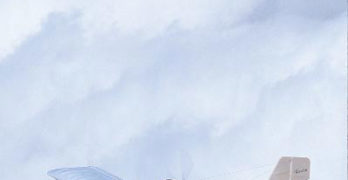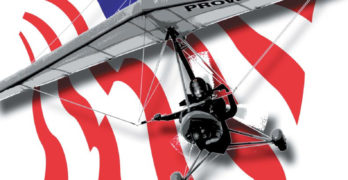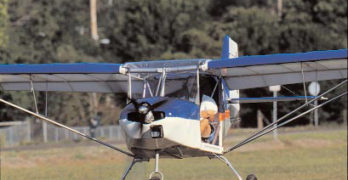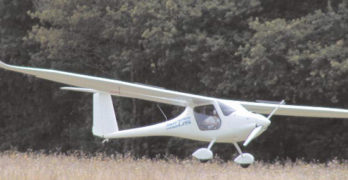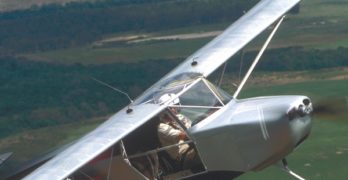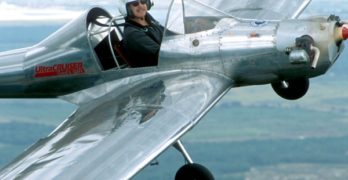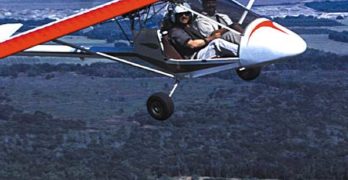“White, composite, and from overseas”…was a theme
of EAA AirVenture Oshkosh 2002 in the ultralight/lightplane
area. I’ve already congratulated Experimenter
Editor Mary Jones and Art Director Pierre Kotze on the
October issue’s beautiful layout of the aircraft from
afar, which may become near and dear to Yankee pilots.
This month,
I’d like to introduce
you
to one of the
new flock of white, composite,
and overseas aircraft—Remos Aircraft’s
G-3 Mirage.
For the second EAA AirVenture
Oshkosh in a row, I was delighted to
fly with Allistair Wilson, an Irishman
now residing in the United States.
Like last year, he is working with Rob
Rollison and the Rollison Light Sport
Aircraft Inc., based in Bloomfield, Indiana.
Last year, Allistair and I flew
in the Flight Designs CT. This year it
was the Remos G-3. Both are white,
composite, and from overseas. The
trend is real!
The Factory and People
In addition to flying with Allistair
at AirVenture, I also chanced to meet
the G-3 Mirage designer, Lorenz Kreitmayr,
at a French ultralight show
called Blois (the town it’s near).
Search Results for : four-stroke
Not finding exactly what you expected? Try our advanced search option.
Select a manufacturer to go straight to all our content about that manufacturer.
Select an aircraft model to go straight to all our content about that model.
Rans S-12S Super Airaile
A brave new world of “sport pilot” approaches. Like all things new, it has plenty of allure and some uncertainty attached to it. Its promise is great, but no one, including FAA, can predict how it will turn out. In such times familiar and reliable aircraft become as comfortable as a well-worn helmet. Such standard bearers may not seem as exciting as a new machine, but you can count on them to behave with good manners. In aviation, no proof is better than years of field experience in the hands of many owners.
Into this hazy future flies one aircraft
that qualifies as a known
quantity. The RANS Inc. Airaile
S-12 and S-14 models have established
themselves as some of
ultralight aviation’s most popular aircraft.
RANS reports close to 1,000
Airailes sold (800-plus S-12s, more
than 100 S-14s, and about a dozen S-
12S models). This blows away every
RANS model line except the ubiquitous
S-6 Coyote series; however, even
the S-6 counts only a couple hundred
more deliveries.
American Trikes
Made in the USA and Yankee friendly!
Many pilots and even some experts believe trikes are a European innovation. Indeed, producers across the Atlantic took the breed to new heights, yet the fact remains that the earliest commercial producers of weight-shift trikes were here in the United States. In the early 1980s trikes were primarily an American phenomenon.
In the early days, before ultralights
had been defined, hang gliders
added power and slowly evolved to
use wheeled carriages. The first
producers included brands that
transitioned from the hang gliding
world, such as Soarmaster, Bennett
Delta Wings, and Flight Designs (no
relation to the German producer of
the CT). All of these American names,
and a good many more, are now
gone.
Today, when you hear the word
trikes, you may think of Air Creation,
Cosmos, Pegasus, AirBorne, or other
companies from Great Britain,
Europe, or Australia. Most of the
development work in trikes has
seemed to come from imported
brands.
Sky Ranger
The Leading Trainer in French Flight Schools
To many observers, the Sky Ranger looks like a RANS Coyote. Based on general appearances, it appears the French light plane borrowed heavily from the popular model sold by the Kansas light plane kit leader. But, Sky Ranger importer Richard Helm bristles a bit when he hears that statement and retorts, “People compare the Sky Ranger to the RANS Coyote. They say it’s a knockoff, but the French designer didn’t take anything from the Coyote. It’s built completely different,” although he admits, “It does look a lot like the Coyote.”
Give a Yankee welcome to the Sky
Ranger. The French-designed
ultralight is typical of a trend I
think we’ll be seeing with increasing
frequency—imported light planes from
Europe. Sky Ranger is built in the
Ukraine by Aeros, Ltd. I visited this
factory with Phil Lockwood of
Lockwood Aviation in the spring of
2001. Once built by Synairgy in France,
Sky Ranger production moved to this
former eastern-block country in 1997.
Europe Embraces Light-Sport Aircraft
Many excellent aircraft may be headed our way
Parlez-vous Française? Sprechen Sie Deutsche? Parlate Italiano? Fortunately, to understand European recreational aircraft you don’t need to speak French, German, or Italian. Yet the light-sport aircraft (LSA) that may interest you could come from countries where the mother tongue isn’t English.
Welcome to the globalized
world of light-sport
aircraft where the workers
who built your plane may speak
Polish, Russian, Hungarian, or
Latvian in addition to French,
German, or Italian.
Though many intriguing
ultralights come from Europe and
Americans have seen a few of these,
many are a complete surprise to
Yankee pilots. That will change.
Last year after EAA AirVenture
Oshkosh 2002 ended, I traveled to
Blois (pronounced Blwah), France, a
town about 200 kilometers south of
Paris. There I attended the 22nd
salon (or air show) that organizers
present at this location each year in
late summer. Let’s take a walk
around the salon at Blois.
Hawks and their History – Sidebar
CGS Aviation Hawk Specifications
(Note: All specs and performance provided by factory. Figures are unverified except as otherwise stated in article.)
Single-Seaters
Two-Seaters
Wingspan (feet)
Wing area (square feet)
Seating*
Empty weight (pounds)
Gross weight (pounds)
Fuel (gallons)
Speed (mph)
Cruise speed (mph)
Rate of climb (fpm)
Takeoff role (feet)
Landing roll (feet)
Standard Rotax engine **
Horsepower (standard engine)
Retail price (US$)***
Assembly time (hours)
Units delivered to date***
Classic
Arrow
28.8
28.8
135
135
1
1
254
282
650
650
5
5
100
100
55-75
55-75
800
800
150
175
150
175
447
447
40
40
11,650
12,800
100-150
100-150
950
100
Plus TD
Classic II
Arrow II
28.8
34.0
34.0
135
159
159
1
2-Tan
2-Tan
350
395
420
800
950
950
10
10
10 Vne
120
100
100
60-80
55-75
55-75
800
800
700
200
175
220
200
175
200
447
503d
503d
40
50
50
13,200
14,750
15,990
100-150
100-150
100-150
60
320
120
*SS = side-by-side seating; Tan = tandem seating
**d = dual carbs – Many Hirth engines have also been fitted in addition to the four-stroke HKS.
An Escapade Just for You
Engineering design is usually an evolutionary process. While occasionally a breakthrough idea comes to market, most development in aviation is a result of small steps. The Escapade is a good example.
Once Flying K Enterprises (now Sky Raider LLC) offered their Sky Raider. The single-seater had much in common with the immensely popular SkyStar Aircraft Kitfox. In fact, when SkyStar offered their Kitfox Lite single-seater, Flying K built the welded fuselage for them.
Then came the Sky Raider II with a tight back seat that could be used for an occasional ride though not instruction as no controls were installed in the rear. The new Summit offered by Just Aircraft late last year was a variation on the Sky Raider II theme.
Company leadership changes as do their designs and the path from Flying K to Just Aircraft is convoluted; other business names are involved. By example, Rocky Mountain Wings, run by former Flying K partner Stace Schrader, offers their very similar Ridge Runner.
Cosmos Phase III
One of the first trikes I flew was a Cosmos, way back in 1984. It was a trendsetter then and was one stoutly built trike capable of real functions. The reason I flew and owned a Cosmos in those early ultralight days was due to its capability as a tug for hang gliders. I’ve been involved with hang gliding for many more years than powered ultralights so when the two dovetailed in the Cosmos Tug, I was pleased to the point of purchase. Maybe you’ll also be so moved.
Today’s Cosmos Phase III trike is vastly better than that ’84 model. But it retains the brand familiarity (albeit with different ownership) and functionality while increasing the state of the art to a highly refined point.
In the 18 years since that first Cosmos experience, I’ve flown all Cosmos entries except the Echo. This new Phase III appeared in many ways to be the French company’s finest work.
Long-Lasting UltraCruiser Fun Plane
A Gift of Design
The UltraCruiser was born under rather unusual circumstances. Its designer, Morry Hummel, was not a young engineer with a passion for flying ultralights. On the contrary, Hummel is one of aviation’s pioneers with many years of experience. His story identifies how he found the time to create the UltraCruiser and, in particular, why the ultralight is fully named UltraCruiser, God’s Gift.
Hummel wrote, “I crashed my miniMAX on July 19, 1995. I lost my right leg below the knee, my left leg was badly broken, and my face crushed. My teeth were wired shut for 10 weeks and I was fed through a tube in my stomach.
“While I was in the hospital for 5 months, I had time to think. God had spared my life for a reason. The UltraCruiser is named God’s Gift because I am only 85 years young and flying again.”
I found it an inspiring story.
New Kolb Aircraft
Sometimes I’m amazed that we’ve now got ultralight pilots buying engines that cost more than $10,000. Twenty years ago, Eipper Formance (Quicksilver) sold complete ultralights that cost $3,499. Even in the ’90s, many complete ultralights – engine and all – cost less than the price of a Rotax 912 4-stroke engine on its own. One that meets that description is Kolb Aircraft’s Mark III with a 50-hp Rotax 503 dual carb 2-cycle engine.
Nonetheless, the 81-hp Rotax 912 has invaded the realm of what is loosely called “ultralight” flying. Of course, a Rotax 912-powered aircraft simply cannot be used on a single-place Part 103 ultralight. And any 2-place plane with a 912 is less likely to qualify as an ultralight trainer under the training exemption to FAR Part 103; the big engine may push the plane too fast and could make it heavier than 496 pounds (the ultralight trainer empty weight limit).
- « Previous Page
- 1
- …
- 9
- 10
- 11
- 12
- 13
- Next Page »


